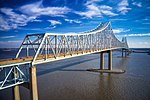The Delaware River Iron Ship Building and Engine Works (founded in 1871), was a major late-19th-century American shipyard located on the Delaware River in Chester, Pennsylvania. It was founded by the industrialist John Roach and is often referred to by its parent company name of John Roach & Sons, or just known as the Roach shipyard. For the first fifteen years of its existence, the shipyard was by far the largest and most productive in the United States, building more tonnage of ships than its next two major competitors combined, in addition to being the U.S. Navy's largest contractor. The yard specialized in the production of large passenger freighters, but built every kind of vessel from warships to cargo ships, oil tankers, ferries, barges, tugs and yachts.
Following a protracted dispute over a U.S. Navy contract for the USS Dolphin in the early 1880s, the company's founder John Roach placed John Roach & Sons into receivership in 1885. After settlement of the parent company's debts, the Delaware River Iron Ship Building and Engine Works was reopened by Roach's sons and continued in operation until shortly after the death of Roach's eldest son John Baker Roach in 1908, at which point the Roach family retired from the shipbuilding business.
Over the course of its 37-year history, the Roach shipyard had many notable achievements to its credit. In 1874 it built City of Peking and City of Tokio, the two largest gross-tonnage ships ever built in the United States to that date and the second largest in the world after the experimental British behemoth Great Eastern. In 1883 it constructed America's first steamer with a steel-plated hull, Alaskan. The yard played a key role in the so-called "Birth of the New Navy" when it built the four "ABCD ships"—the U.S. Navy's first steel ships. It also established a reputation for itself as a builder of lavishly outfitted "night boats" for the Long Island Sound trade, and in its last years, built the first three American ships to be powered by steam turbines. In total, the Delaware River Works built 179 ships between 1871 and 1908, including 10 warships for the U.S. Navy.
Following the retirement of the Roach family in 1908, the shipyard remained idle for some years until being reopened as the Chester Shipbuilding Co. by a naval officer, C. P. M. Jack, in 1913. It was subsequently purchased in 1917 by W. Averell Harriman for building merchant ships during World War I, when it was renamed the Merchant Shipbuilding Corporation. The yard closed permanently in 1923, and the location repurposed as the Ford Motor Company Chester Assembly factory until 1961.








